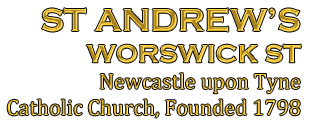

Location: home/father worswick
Father Worswick

St Andrew’s in Worswick Street, Newcastle occupies a pre-eminent position in the story of Catholic Tyneside, largely through its extraordinarily dynamic first pastor, James Worswick (portrait shown above). Born in Lancaster in 1771, Worswick joined the English College at Douai in France in 1782 as a schoolboy but when the French Revolution broke out seven years later, the seminary was suppressed. Worswick and four other students made their way to the allied armies of the Duke of York, who gave them money and passports to return to England.
The young man resumed his theological studies at Crook Hall near Durham and was ordained a priest in 1795 and appointed to take charge of the “secular mission” in Newcastle. Thus began 48 years of unremitting endeavour which saw the Catholic community increase hugely in size, mostly as a result of Irish immigration, thus posing problems of Mass access, education of the young, even health and welfare at a time when plagues were common.
An historical account said Fr Worswick’s flock in 1795 “was perhaps a few hundred ... but by 1832 ... he had in his care over half of the 8,000 Catholics in Northumberland.” He addressed these problems with an energy that made his name known across Tyneside. Only months after his appointment, he bought a house with a large garden in Pilgrim Street, Newcastle. The house became the priests’ residence and behind it he built a church - the first new Catholic church in Newcastle since the Reformation -- which was dedicated to St Andrew and opened on February 11, 1798. Schoolrooms were built for boys and girls.
The banks of the Tyne, as far down the river as North and South Shields, were by now hosts to growing numbers of Catholics whose nearest church was St Andrew’s. Getting to Mass on a Sunday, including, for many a two-penny boat ride across the river, was a whole-day occupation and Fr Worswick established a “Mass House” at North Shields. He could not leave St Andrew’s on Sundays, so he rode on horse-back to North Shields on Tuesdays. In 1821, he opened St Cuthbert’s church in North Shields to serve the town and South Shields, Willington Quay and Jarrow. He also oversaw the construction of St Patrick’s, Felling, which was funded by the assistant priest at St Andrew’s, Fr William Riddell of the Northumberland Riddell family.
Back in Newcastle, Fr Worswick faced the same problem of growing numbers. Four times, he increased the capacity of St Andrew’s, erecting galleries to accommodate 1,000 worshippers. But it was not enough and in 1836 a public meeting was held at St Andrew’s School to consider building another church in Newcastle which would hold 1,200. This was the beginning of St Mary’s Cathedral, which was completed in 1844, famously built “by the pennies of the poor.” Fr Worswick, a leading contributor to the project in expertise and funds, died on July 8, 1843 and was buried in the unfinished church, originally in a vault beneath the sanctuary floor. When the cathedral was re-ordered in 1983, his sepulchral slab was moved to the floor of the Blessed Sacrament Chapel.
After Fr Worswick, St Andrew’s was made available to the Dominicans who began to serve the parish in 1860 at a time when Newcastle Council planned great changes in the Pilgrim Street area - a new police court, fire station and an access road to the then Town Gaol. The church trustees agreed that the St Andrew’s site - presbytery, church and schools could be removed provided the Council supplied alternative sites in the area free of charge. A site for the school at Manors was quickly agreed but it was only after protracted discussions that an area of land behind the new police court was accepted for the church.
Construction was delayed while work went ahead dressing stone for the court, and the subsequent discovery that sound load-bearing ground was 30 feet deeper than expected lengthened the timetable for the new St Andrew’s even further. This latter problem absorbed most of the money in hand and left a large debt once the church was completed. However, the foundation stone was laid in 1874 and the new church was opened on September 26, 1875.

Although Fr Worswick’s church was destroyed, the Council was happy to name the neighbouring street after him and around 2010 a black “famous people” plaque honouring the founder/builder was fixed to the wall of the church on Worswick Street.
In the years since the current St Andrew’s was erected, it has been served by more than a dozen parish priests and more than three dozen assistant priests. The life of St Andrew’s, like most Catholic churches, revolved around the sacred services and a strong musical tradition, with social activities, pre-eminently fund-raising, high on the secular agenda. The debt was cleared and the church consecrated by Bishop Collins on September 27, 1921, the day after its 46th birthday.
That poverty was endemic in the area is reflected in the financial records over the years and the exhortations of pastors to greater generosity. “We should like to see more silver and fewer halfpennies on the plate,” commented one priest after counting the Easter offering.
In modern times, the parish population has dwindled dramatically as a result of demographic changes, but conversely it has become an important mass centre for shoppers, city workers and the increasing number of local and foreign students at the city’s two universities.
A notable item on St Andrew’s historical record is its successful hosting of the relics of St Therese of Lisieux for 20 hours on September 30/October 1, 2009. Parish priest Fr Michael Corbett said at the time that he was deeply moved by the prayerful nature of the event which attracted some 4,000-5,000 worshippers from all over the diocese and beyond.
